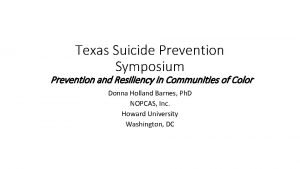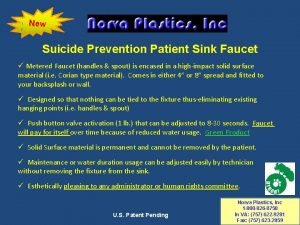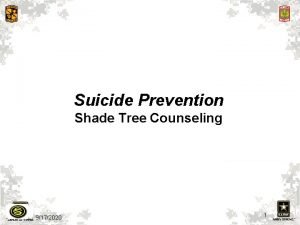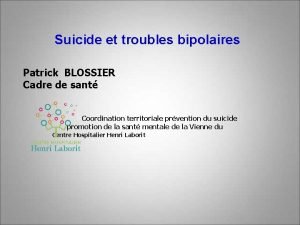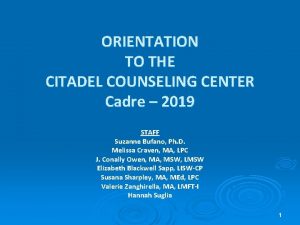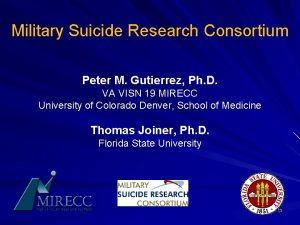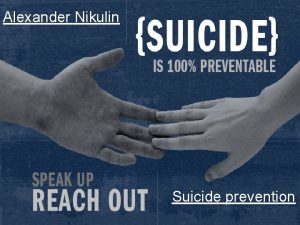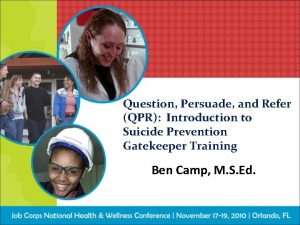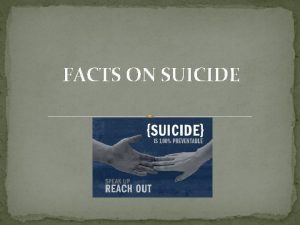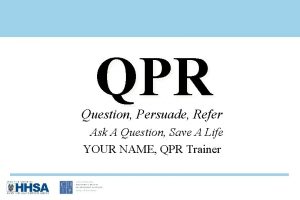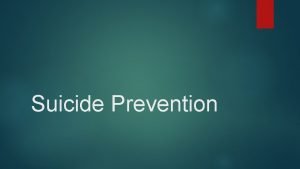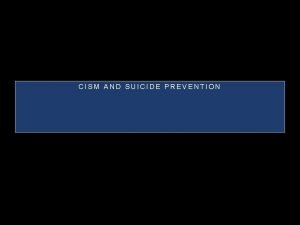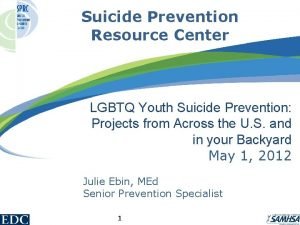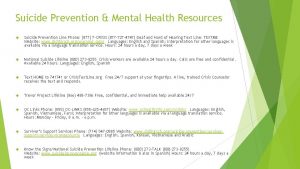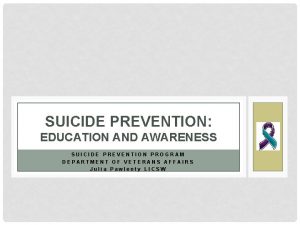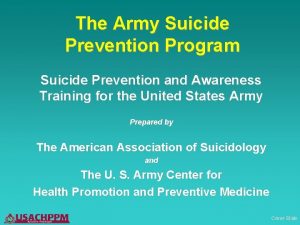Question Persuade Refer SUICIDE PREVENTION Facts Utah has














- Slides: 14

Question, Persuade, Refer SUICIDE PREVENTION

Facts Utah has the 17 th highest youth suicide (ages 10 -17) and the 11 th highest young adult (ages 18 -24) suicide rate in the U. S. Suicide is the 2 nd leading cause of death for Utah youth (ages 10 -17) and young adults (ages 18 -24). On average, Two youth (ages 10 -17) are treated for suicide attempts every day in Utah. Three young adults (ages 18 -24) are treated for suicide attempts every day in Utah.

There age-specific circumstances and stressors surrounding risk for suicide deaths in Utah. For example, youth who completed suicide were more likely to have school and other relationship problems, while young adults were more likely to have intimate partner problems. Among adults , the data show many suffered from a diagnosed mental illness. Adult men in particular face a myriad of other risk factors, including alcohol and substance abuse and job or financial problems. Older adults were more likely to suffer from physical health problems that may have prompted the suicide.

Alienation Feeling isolated and separated from everyone else Suicide the act of intentionally taking of one’s own life

Question 1: What do you think are some suicide warning signs?

Warning Signs Most people who attempt suicide give some warning Some warning signs include: Sudden or extreme changes in moods or personality Prolonged depression Consistent low energy level Avoidance of activities with friends or family Taking greater risks than usual Substance abuse Giving away prized possessions Talking about death or making suicide threats

Suicide Spiral Feeling helpless, hopeless, and hapless (without happiness) where multiple life events consume one's emotional resources and the last one is like the last straw that broke the camel's back.

Question 2: What do you think are some possible responses to a threatened suicide attempt?

Some responses to a threatened suicide might be: Assume it is a joke and laugh it off Ignore it Get mad, lecture or criticize Tell someone Talk to a friend about the threats *Suicide is a serious matter and suicide warnings and threats should not be ignored. *Friends should take threat seriously, show a caring attitude, remain calm and listen, and use the skills learned in this lesson to offer help.

QPR like CPR Both are lifesaving techniques if used properly Both require practice to be used effectively Both must be used after warning signs of need are detected

Q=Question the person to determine what he or she is thinking about suicide. Are you joking? Are you serious about what you said? Are you thinking about harming yourself? What do you mean by what you just said? Are you thinking about suicide? Tips Plan a time and place to talk to the person Try to get the person alone or in a private place Give yourself plenty of time Don’t be afraid to ask. Asking might save a life

P=Persuade the person to get help Let me help you. Let’s go get some help. Come with me to talk to the counselor. I want to help. Let’s make and appointment with ______. I know where we can get help. Let’s call the Teen Hotline. Tips Give the person your full attention Listen carefully and let him or her talk Let the person know you care Don’t judge or condemn the person Accept the reality of his or her pain Insist that suicide isn’t a good solution Offer hope in any form.

R=Refer the person to someone who can help The best referrals are when you personally take the person to get help The next best is when a person agrees to see a professional and you know he or she goes. If the person doesn’t get help, make certain you notify someone who can follow through. Contact a parent, church leader, teacher, coach, counselor, hotline, doctor or trusted adult in the community. Tips Don’t promise secrecy Don’t worry about being disloyal Get an adult or professional involved; don’t try to handle it yourself Remember that you aren’t responsible for people’s actions

Group Practice Mike’s Story Lisa’s Story Peter’s Story Melissa’s Story
 Primary prevention secondary prevention tertiary prevention
Primary prevention secondary prevention tertiary prevention Mad acronym suicide prevention
Mad acronym suicide prevention Chapter 5 lesson 3 health
Chapter 5 lesson 3 health Suicide prevention chain teach
Suicide prevention chain teach Texas suicide prevention symposium
Texas suicide prevention symposium Mental health faucets
Mental health faucets Army suicide prevention situational questions
Army suicide prevention situational questions Prévention du suicide
Prévention du suicide Suicide prevention month quotes
Suicide prevention month quotes Army suicide prevention training
Army suicide prevention training Vivien blossier
Vivien blossier Costa assessment answers
Costa assessment answers Sara calixto boy girl
Sara calixto boy girl Citadel counseling center
Citadel counseling center Youth suicide research consortium
Youth suicide research consortium




